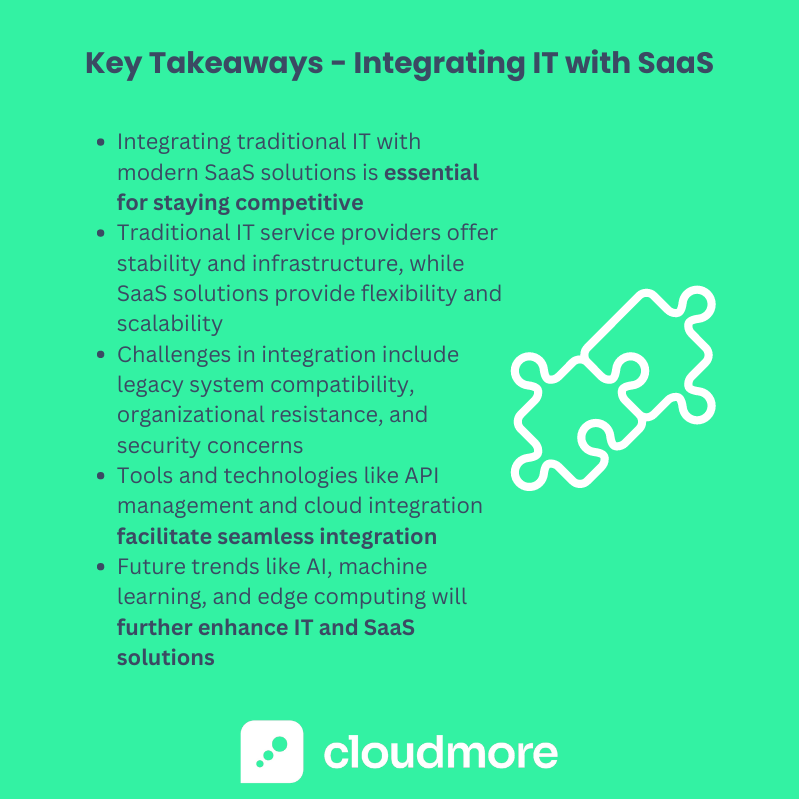Building Bridges: Integrating Traditional IT Service Providers with Modern SaaS Solutions
In the dynamic realm of technology, the convergence of traditional IT service providers and modern Software-as-a-Service (SaaS) solutions marks a pivotal moment of innovation and opportunity.
Today, businesses navigate a landscape where legacy infrastructure meets the agility of cloud-based applications, ushering in a new era of IT evolution.
In this article, we explore the significance of integrating traditional IT with SaaS, exploring the benefits, challenges, and strategies for successful integration. From enhancing service delivery to unlocking new possibilities with emerging technologies, the journey of integration promises unparalleled growth and competitiveness in the digital age.
Join us as we uncover the keys to bridging the gap between tradition and innovation, propelling your organization toward a future of seamless connectivity and unparalleled efficiency.
Understanding the Landscape
Integrating traditional IT service providers with modern SaaS solutions is crucial in today's digital era. To appreciate this, it's essential to understand both landscapes clearly.
Traditional IT Service Providers: Overview
Definition and Examples
Traditional IT service providers offer a range of technical services to businesses. These services often include on-premises infrastructure, hardware support, and network management. Examples of conventional IT providers include IBM, Hewlett-Packard (HP), and Accenture.
Common Services Offered
Traditional IT service providers typically offer:
- Infrastructure Management: Maintaining and upgrading hardware and software systems.
- Network Management: Ensuring secure and efficient data communication across company networks.
- Technical Support: Providing troubleshooting and technical assistance to resolve IT issues.
- System Integration: Combining different IT systems and ensuring they work together seamlessly.

Modern SaaS Solutions: Overview
Definition and Examples
Software as a Service (SaaS) is a cloud-based model where software applications are delivered over the internet. Users can access these applications via a web browser without installing or maintaining the software themselves. Examples of SaaS providers include Salesforce, Google Workspace, and Microsoft 365.
Benefits of SaaS
SaaS solutions offer several advantages:
- Scalability: Easily adjust services based on your business needs.
- Cost Efficiency: Reduce upfront costs with subscription-based pricing.
- Accessibility: Access applications from anywhere with an internet connection.
- Automatic Updates: Receive the latest features and security updates without manual intervention.

Understanding these two landscapes sets the stage for exploring how they can be integrated to enhance business operations and drive growth.
The Need for Integration
Integrating traditional IT service providers with modern SaaS solutions is not just a trend but a necessity. The evolving market demands and the advantages it brings make integration essential for staying competitive.
Market Trends and Customer Demand
Businesses are increasingly embracing digital transformation. This shift involves adopting new technologies to improve processes, enhance customer experiences, and drive innovation. Traditional IT services alone can't keep up with the pace of change. That's where SaaS comes in, offering agility and modern capabilities.
Today's market demands flexibility and scalability. Companies need IT solutions that can grow with their business. SaaS offers a scalable model that adapts to varying demands. This flexibility is crucial for companies looking to expand without being bogged down by legacy systems.
Advantages of Integrating Traditional IT with SaaS
Integrating traditional IT with SaaS enhances service delivery. You get the best of both worlds: robust infrastructure from traditional IT and innovative, user-friendly applications from SaaS. This combination ensures better performance and reliability.
Integration also leads to cost efficiency. SaaS reduces the need for significant upfront investments in hardware and software. With a subscription model, you only pay for what you use. Moreover, operational agility improves as businesses can quickly adapt to market changes, deploy new services, and streamline processes.
Integrating traditional IT with SaaS solutions is a strategic move. It aligns with market trends and meets customer demands while offering significant operational advantages.
Challenges in Integration
While integrating traditional IT service providers with modern SaaS solutions offers many benefits but presents several challenges. Understanding these challenges is crucial for a successful integration.
Legacy System Compatibility
Legacy systems often pose significant hurdles. These systems are usually outdated and lack the flexibility to integrate with modern SaaS solutions. They can be rigid and resistant to change, making integration complex and time-consuming.
One of the major challenges is ensuring legacy systems work flawlessly with modern SaaS solutions. Integration testing helps identify and resolve compatibility issues early in the process.
Security is another significant concern when integrating old and new technologies. Legacy systems may not have the same security features as modern SaaS applications. This discrepancy can create vulnerabilities, exposing your organization to potential cyber threats. Ensuring robust security measures during the integration process is essential.
Organizational Resistance
Introducing new technologies often meets resistance from within the organization. Employees may be comfortable with existing systems and reluctant to adopt new ones. Effective change management strategies are necessary to address these concerns. Clear communication and involving staff in the transition can help ease this resistance.
A skills gap could also hinder the integration process. Traditional IT staff may not have the expertise needed to manage SaaS solutions. Providing adequate training and upskilling opportunities is vital. This investment ensures your team can effectively handle the new technologies and maximizes the benefits of integration.
Addressing these challenges head-on is critical to successful integration. By preparing for these obstacles, you can ensure a smoother transition and fully leverage the advantages of combining traditional IT with modern SaaS solutions.
Strategies for Successful Integration
Integrating traditional IT with modern SaaS solutions requires careful planning and strategic implementation. Adopting the right strategies can overcome challenges and ensure a seamless integration process.
Assessing Current Infrastructure
Begin by conducting a comprehensive audit of your current IT infrastructure. Assess existing systems, applications, and processes to identify areas that need improvement or replacement. This audit will help you understand your organization's technology landscape and pinpoint integration opportunities.
Once you've assessed your infrastructure, identify potential integration points between traditional IT and SaaS solutions. Look for areas where SaaS applications can complement or enhance existing systems. Prioritize integration projects based on their potential impact on business operations and objectives.
Ensuring Data Security and Compliance
Data security is paramount when integrating traditional IT with SaaS solutions. Implement robust security measures to protect sensitive information and mitigate cybersecurity risks. This includes encryption, access controls, and regular security audits to identify and address vulnerabilities.
Additionally, securing user accounts is critical in a cloud-based environment. Organizations should enforce strong password policies, encourage the use of password managers for teams, and implement multi-factor authentication (MFA) to reduce the risk of unauthorized access. Regularly reviewing user permissions and monitoring for suspicious activity further strengthens security.
You'll also need to ensure compliance with relevant regulations and industry standards when integrating IT and SaaS systems. Understand the data privacy laws and compliance requirements that apply to your organization. This knowledge will guide your integration efforts and help you avoid costly penalties or legal issues.
By following these strategies, you can navigate the complexities of integration and succeed in merging traditional IT with modern SaaS solutions.
Tools and Technologies Facilitating Integration
Various tools and technologies are available to integrate traditional IT with modern SaaS solutions seamlessly. Understanding these tools and their role in integration is essential for a smooth transition.
API Management Platforms
Application Programming Interfaces (APIs) connect different systems and enable seamless data exchange. APIs allow applications to communicate with each other, facilitating integration between traditional IT systems and SaaS solutions. By standardizing communication protocols, APIs streamline the integration process and ensure compatibility between disparate systems.
Several API management platforms are available to help organizations manage and secure their APIs effectively. Tools like Apigee, MuleSoft Anypoint Platform, and IBM API Connect offer API design, deployment, monitoring, and analytics features. These platforms empower businesses to orchestrate complex integrations, enforce security policies, and optimize API performance.
Cloud Integration Platforms
Cloud integration platforms provide a centralized environment for integrating on-premises and cloud-based applications. They offer scalability, flexibility, and cost-effectiveness, making them ideal for modern integration needs. Cloud integration platforms enable organizations to connect diverse systems, automate workflows, and access data from anywhere, improving agility and collaboration.
Leading cloud integration solutions include platforms like Dell Boomi, Informatica Cloud, and Azure Integration Services. These platforms offer a range of capabilities, including data integration, application integration, and API management. With features such as pre-built connectors, drag-and-drop interfaces, and advanced orchestration capabilities, these solutions simplify the integration process and accelerate time to value.
By leveraging API management platforms and cloud integration solutions, organizations can overcome integration challenges and unlock the full potential of combining traditional IT with modern SaaS solutions. These tools empower businesses to innovate, optimize processes, and drive digital transformation effectively.
Future Trends and Innovations
As technology evolves, future trends and innovations shape the landscape of IT service delivery and SaaS solutions. Understanding these trends is essential for staying ahead of the curve and driving innovation within your organization.
AI and Machine Learning
Artificial Intelligence (AI) and Machine Learning (ML) are revolutionizing IT service delivery and SaaS solutions. These technologies enable predictive analytics, automation, and intelligent decision-making, enhancing efficiency and productivity. AI-powered algorithms can analyze vast amounts of data to identify patterns, predict future trends, and optimize performance.
Predictive analytics, in particular, leverage AI and ML algorithms to forecast future events and outcomes based on historical data. In the context of IT service delivery and SaaS, predictive analytics can anticipate potential issues, proactively identify opportunities for optimization, and automate routine tasks. This predictive capability enables organizations to preemptively address issues, minimize downtime, and enhance user experiences.
Edge Computing
Edge computing brings computing resources closer to the source of data generation, enabling real-time processing and analysis. This distributed architecture reduces latency and bandwidth usage, making it ideal for low-latency and high-reliability applications. In IT service and SaaS integration, edge computing enables faster response times, improves data security, and enhances user experiences.
Edge computing has numerous use cases in IT service and SaaS integration. For example, it can process sensor data in real-time, enabling predictive maintenance for IT infrastructure. In SaaS applications, it can optimize performance by caching frequently accessed data locally, reducing reliance on centralized servers and improving scalability.
Embracing AI, machine learning, and edge computing will be critical to driving innovation and competitiveness in the future. By leveraging these technologies, organizations can enhance IT service delivery, optimize SaaS solutions, and deliver superior customer and user experiences.
Key Takeaways about Integrating IT Service Providers with Modern SaaS Solutions

- Integrating traditional IT with modern SaaS solutions is essential for staying competitive in today's digital landscape.
- Traditional IT service providers offer stability and infrastructure, while SaaS solutions provide flexibility and scalability.
- Challenges in integration include legacy system compatibility, organizational resistance, and security concerns.
- Strategies for successful integration include assessing current infrastructure, adopting a hybrid model, and ensuring data security and compliance.
- Tools and technologies like API management platforms and cloud integration solutions facilitate seamless integration.
- Future trends like AI, machine learning, and edge computing will further enhance IT service delivery and SaaS solutions.
Final Thoughts on the Importance of Integrating Traditional IT with Modern SaaS
In conclusion, integrating traditional IT service providers with modern SaaS solutions is not just a trend; it's a strategic imperative. By bridging the gap between legacy systems and innovative technologies, organizations can unlock new opportunities for growth, agility, and efficiency.
Embracing integration enables businesses to meet evolving customer demands, drive digital transformation, and stay ahead of the competition. As you navigate the integration journey, remember to leverage the right tools, address challenges proactively, and embrace emerging technologies to maximize the benefits of integration.
Traditional IT and modern SaaS solutions pave the way for a more agile, resilient, and future-ready organization.
Share this
You May Also Like
These Related Stories

Advantages of Using a Separate Billing and Invoicing Solution in a B2B Scenario

Creating Adaptive Technology Infrastructures with Enterprise SaaS


